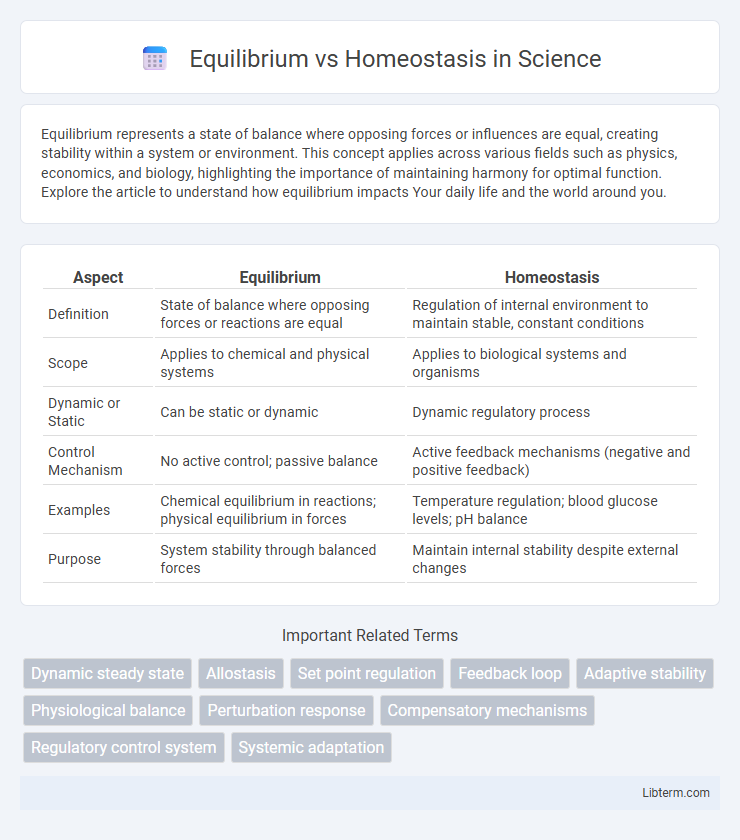Equilibrium represents a state of balance where opposing forces or influences are equal, creating stability within a system or environment. This concept applies across various fields such as physics, economics, and biology, highlighting the importance of maintaining harmony for optimal function. Explore the article to understand how equilibrium impacts Your daily life and the world around you.
Table of Comparison
| Aspect | Equilibrium | Homeostasis |
|---|---|---|
| Definition | State of balance where opposing forces or reactions are equal | Regulation of internal environment to maintain stable, constant conditions |
| Scope | Applies to chemical and physical systems | Applies to biological systems and organisms |
| Dynamic or Static | Can be static or dynamic | Dynamic regulatory process |
| Control Mechanism | No active control; passive balance | Active feedback mechanisms (negative and positive feedback) |
| Examples | Chemical equilibrium in reactions; physical equilibrium in forces | Temperature regulation; blood glucose levels; pH balance |
| Purpose | System stability through balanced forces | Maintain internal stability despite external changes |
Introduction to Equilibrium and Homeostasis
Equilibrium refers to a state of balance where opposing forces or influences are equal, commonly observed in physical, chemical, and biological systems. Homeostasis is the dynamic process by which living organisms maintain internal stability, such as temperature and pH, despite external environmental changes. Both concepts are fundamental in understanding how systems achieve and sustain stability, but homeostasis specifically pertains to biological regulatory mechanisms.
Defining Equilibrium in Biological Systems
Equilibrium in biological systems refers to a state where the chemical or physical processes occur at equal rates, resulting in no net change in the concentrations of substances involved. This dynamic balance is crucial in processes like enzyme function and cellular respiration, where reactants and products maintain stable ratios despite ongoing reactions. Unlike homeostasis, which actively regulates internal conditions to remain constant, equilibrium denotes a passive balance without external energy input.
Homeostasis: Concept and Mechanisms
Homeostasis is the biological process by which organisms maintain internal stability despite external environmental changes. This dynamic mechanism relies on feedback systems, such as negative feedback loops, to regulate critical variables including temperature, pH, and glucose levels. Key components involved in homeostasis include sensors that detect deviations, control centers that process information, and effectors that initiate corrective responses to restore balance.
Key Differences Between Equilibrium and Homeostasis
Equilibrium refers to a state of physical or chemical balance where opposing forces or reactions are equal, often seen in contexts like chemical reactions or ecosystems. Homeostasis, on the other hand, is a biological process that maintains internal stability within an organism despite external environmental changes. Key differences include equilibrium being a static state focused on balance, while homeostasis is dynamic, involving regulatory mechanisms to preserve optimal conditions for survival.
The Role of Feedback Loops in Homeostasis
Feedback loops in homeostasis play a critical role by continuously monitoring and adjusting physiological parameters to maintain internal stability. Negative feedback loops detect deviations from set points and initiate responses to restore balance, such as regulating body temperature or blood glucose levels. Positive feedback loops amplify certain processes temporarily, like in blood clotting, to achieve specific outcomes before normal homeostatic conditions are reestablished.
Dynamic vs Static Balance Explained
Equilibrium refers to a dynamic balance where continuous adjustments maintain system stability despite external changes, exemplified by the body's regulation of blood pH through respiratory and renal functions. Homeostasis represents a static balance aimed at maintaining internal conditions within narrow limits, such as consistent body temperature or glucose levels, to ensure optimal cellular function. Understanding the distinction clarifies how living organisms employ dynamic mechanisms to achieve and preserve internal stability in varying environments.
Examples of Equilibrium in Nature
Equilibrium in nature is exemplified by the balanced state of predator and prey populations within an ecosystem, such as the lynx and snowshoe hare dynamics in the boreal forests, where fluctuations in one species directly influence the other's population size. Another example is the chemical equilibrium in aquatic environments, like the carbon dioxide-bicarbonate equilibrium that regulates pH in ocean water to sustain marine life. The stable thermodynamic equilibrium observed in volcanic hydrothermal systems maintains temperature and chemical balances vital for extremophile microorganisms.
Case Studies of Homeostasis in the Human Body
Homeostasis in the human body maintains internal stability through mechanisms like temperature regulation, blood glucose control, and pH balance, illustrated by case studies such as insulin response in diabetes management. Unlike equilibrium, which refers to a static balance, homeostasis involves dynamic adjustments via feedback loops to preserve optimal conditions. Case studies on thermoregulation demonstrate how the hypothalamus triggers sweating or shivering to stabilize body temperature, highlighting the complexity of physiological homeostasis.
Importance of Maintaining Homeostasis and Equilibrium
Maintaining homeostasis is crucial for sustaining stable internal conditions such as temperature, pH, and electrolyte balance necessary for cellular function and overall health. Equilibrium plays a vital role in physiological processes, particularly in systems like fluid balance and nerve signal transmission, ensuring the body adapts to external and internal changes. Together, homeostasis and equilibrium support metabolic stability, immune response, and optimal organ function, preventing disease and promoting survival.
Implications for Health and Disease
Equilibrium in biological systems often refers to a static balance of chemical or physical processes, while homeostasis involves dynamic regulatory mechanisms maintaining internal stability. Disruption of homeostasis can lead to diseases such as diabetes, hypertension, and autoimmune disorders, highlighting its critical role in health maintenance. Understanding the distinction aids in developing treatments that restore homeostatic balance rather than merely addressing equilibrium states.
Equilibrium Infographic

 libterm.com
libterm.com